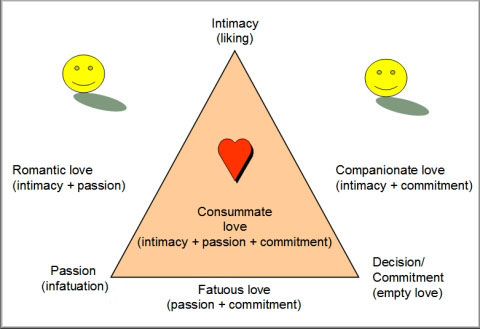|
Ψ Intimacy promotes feelings of affiliation, affection, interdependence, communion, belonging, and love.
• Intimacy is characterized in Erickson’s 6th Psychosocial Stage: Intimacy vs. Isolation.
• Adults seek to find someone with whom to share their lives, in an enduring and self-sacrificing commitment. Without such commitment, they risk profound aloneness, isolated from their fellow humans.
|

|
Friendship
Ψ Gateways to Attraction – the various qualities, such as appearance & proximity, that are prerequisites for the formation of close friendships & ultimate relationships.
• Physical attractiveness (even in platonic & same-sex relationships)
• Apparent availability (demonstrated in willingness to that/do things together)
• Absence of “exclusion criteria” (no
unacceptable characteristics)
• Frequent exposure
Same-Sex Friendships
• Men & women tend to develop somewhat different friendship patterns:
• Female - Female: may be better for meeting intimacy needs & reduces the loneliness and self-absorption that is the danger of the intimacy vs. isolation stage.
• Male - Male: companions typically keep emotional distance while sharing information, activities, & assistance.
• Cross-sex friendship benefits both sexes but is hazardous for other relationships.
The Dimensions of Love
Ψ Robert Sternberg’s 7 forms of love have 3 distinct components, they follow.
• Passion
• Intimacy
• Commitment
|

|
Ψ Robert Sternberg’s 7 forms of love follow.
• Liking - components: I
• Infatuation - components: P
• Empty Love - components: C
• Romantic Love - components: P I
• Fatuous Love - components: P C
• Companionate Love - components: I C
• Consummate Love - components: P I C
legend: P=Passion, I=Intimacy, C=Commitment

Ψ Cohabitation (living together): an arrangement in which adults of the opposite sex are not married but live together in a committed sexual relationship. According to the studies, cohabitation is burdened with negative consequences.
Ψ Purpose of Cohabitation:
• Variation.
• Substitute for marriage.
• Some couples live together but do not plan to marry each other; neither considers the
relationship permanent.
• About 1/2 of cohabiting couples in the U.S. consider living together as a prelude to
marriage, which they expect to occur when they are financially & emotionally ready.
Ψ Marriage & its ideals have changed over time:
• The proportion of adults who are unmarried is higher than in the previous 100 years
• Only 10% of brides are virgins
• Nearly one half of all first births are to single mothers, who are increasingly unlikely to
marry the fathers
• At least another 20% of first births are conceived before marriage
• The divorce rate is 49% of the marriage rate
• The rate of first marriages in young adulthood is the lowest in 50 years
• Most adults aged 20 to 30 are not yet married or already divorced
• Ideally mutually beneficial, a successful marriage is one where the couple’s love & friendship is grown & solidified over time through events such as bearing & raising children, overcoming financial & economic obstacles, surviving setbacks, & sharing social & financial commitments.
• Overall, marriage makes people happier, healthier, & wealthier.
Marriage
Ψ Homogamy: refers to marriage between individuals who tend to be similar with respect to such variables as attitudes, interests, goals, SES, religion, ethnic background, & local origin.
Ψ Heterogamy: refers to marriage between individuals who tend to be dissimilar with respect to such variables as attitudes, interests, goals, SES, religion, ethnic background, and local origin.
Ψ Social Homogamy: the similarity with which a couple regards leisure interests and role preferences. (If both spouses enjoy/hate the same things, they tend to be more “in love,” and if role preferences are agreed on, conflict and ambivalence are reduced)
Ψ Marital Equity - Social Exchange Theory: marriage is (should be) an arrangement in which each person contributes something useful to the other, something the other would find difficult to attain alone.
|

|
Domestic Violence
Ψ Common Couple Violence (CCV): consists of couple conflicts that “get out of hand” & result in minor violence.
Ψ Intimate terrorism: is a systematic, intentional form of violence that is perpetrated most often by males against their partners. Can lead to battered-wife syndrome.
Family Connections
Ψ Modern emerging adults have linked lives in which the success health, & well being of one generation in a family are connected to those of anther generation, as in the relationship between parents & children.
Growth & Development
Robert C. Gates

|
|
















